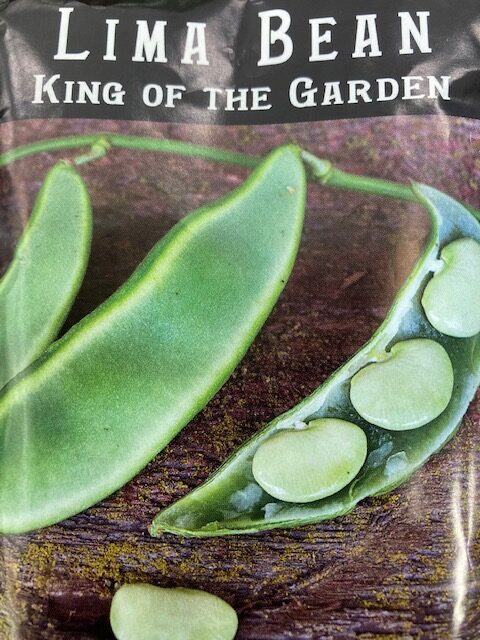
Lima Bean
Also known as the butter bean, the lima bean is a member of the legume family. As such, it is a nitrogen fixer. An interesting fact is that the pods can be eaten, not just the young beans or the dried beans, which are good for storage.
|
Thorogreen (Cangreen Bush) King of the Garden (Pole) |
|
Phaseolus lunatus |
|
Easy |
|
Easy |
|
4 years if properly stored |
|
Annual |
|
6-18 days |
|
None Optional: can add a legume inoculant (follow the packaged instructions) |
|
1 – 1.5 inches |
|
King of the Garden: 8-10 foot vines: trellis needed Thorogreen: bush 18” tall |
|
Full sun |
|
90 days |
|
March, April, May, July |
|
No
|

Growing Tips


12+” container. Pole varieties will need a trellis.
When to Start
Spring: Direct sow after all danger of frost has passed. (Mar 15-Jun 1 for GA)
Fall: Direct sow in mid-summer. (July 1-Aug 1 for GA)
How to start
Know if you have a bush or pole. Pole beans will need a trellis to climb up. Even bush varieties might need a cage. Use tomato cages or plant them close enough that they will support each other if you experience a problem with broken stems. Direct sow after all danger of frost has passed (May 1 for Jefferson, GA) and into full sun beds. Sow to a depth of 1-1.5 inches space seeds 2-4 inches apart and thin to 4-6 inches.
Care
Lima beans like temperatures between 70-80 F. Water inch per week. Lima beans set their crop all at once, so plant successively every 2 to 3 weeks for a consistent harvest throughout the end of the season.
When planting lima beans, try to time the crop so pods will set before the hottest part of the summer as the pods will get woody and bitter in the heat.
Harvest
To harvest young pods, the pods should be bright green and firm. Or wait for them to dry for later storage. Just harvest dried pods before it rains as the moisture could cause the seeds to mold or sprout.
Pro Tip!
Incompatibles: Fennel, garlic, all onions
Grows well with: Carrots, corn, cucumber, eggplants, lettuce, peas, radish.
Seed Saving

Isolation Distance
Members of the Bean Family are self-pollinating and crossing is uncommon, but rare varieties can be separated by 100 feet to ensure purity.
Instructions
Pick beans for seed after the pods are ripe and have dried on the plants. Don’t allow dried pods to get rained on as the beans may quickly mildew or sprout in their pods. When very dry, most pods will split on their own to drop their seeds. The rest can be easily crumbled in the hands and the finer chaff blown away after removing the big pieces. Finish drying the beans in a dry spot indoors or undercover.
A DANGER with members of the Bean Family is late summer rains, which can moisten seeds drying in their pods while still on the vine. Too much moisture during seed maturation lowers the viability and storage life of the finished seeds, and can even cause them to sprout or mildew while still on the vine.
Features
- King of the Garden (Pole): Heirloom. The creamy white seeds have a honey-like flavor. Heavy yielding and freezes well.
- Thorogreen (Cangreen Bush): Heirloom dwarf plant and matures early. Excellent for canning a freezing.

- If you’re eating your beans, allow just one or two pods per plant to remain and mature for seed. Too many pods maturing on an individual plant will cause it to stop setting more beans in order to concentrate on maturing the ones it has.
- If you are seed-saving, as SOON as the seed pods turn brown–Harvest Them. Even a light rain or mist can cause the seeds to swell and sprout in their pods, ruining the viability of the seeds.
Sources:
edenbrothers.com
